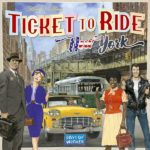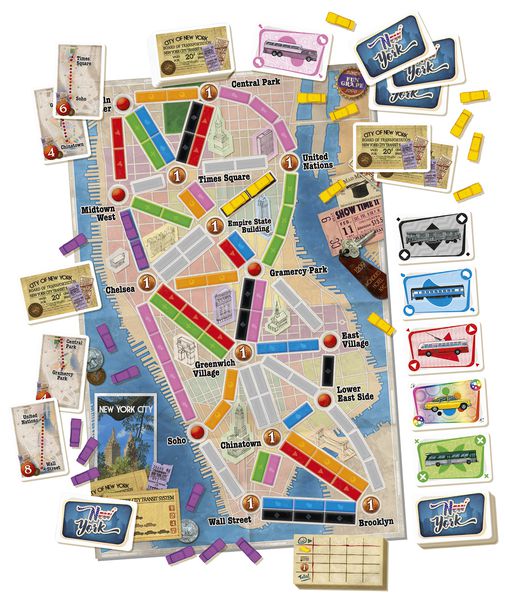Ticket to Ride: New York (Boardgame)
 Arguably the best-selling modern boardgame is Ticket to Ride and its sequels. Players collect sets of train cards (like sets in Rummy), and use them to occupy routes on a game board map of the United States. Players earn points for placing large sets of trains as well as bonus points for managing to connect cities shown on their personal “ticket” cards. Many versions have been released which change the map (Europe, Asia, the UK, etc…) and each add in some small twist to make the version unique. Ticket to Ride: New York is the newest release and it takes most of what is best about the game and distills it down to a small box game, playable in less than 20 minutes (closer to 30-45 minutes if playing with new players.) While the “large box” games tend to allow more long-term grand strategy, New York serves as both a great introduction to the game and a fully playable version when you have less than an hour to spare.
Arguably the best-selling modern boardgame is Ticket to Ride and its sequels. Players collect sets of train cards (like sets in Rummy), and use them to occupy routes on a game board map of the United States. Players earn points for placing large sets of trains as well as bonus points for managing to connect cities shown on their personal “ticket” cards. Many versions have been released which change the map (Europe, Asia, the UK, etc…) and each add in some small twist to make the version unique. Ticket to Ride: New York is the newest release and it takes most of what is best about the game and distills it down to a small box game, playable in less than 20 minutes (closer to 30-45 minutes if playing with new players.) While the “large box” games tend to allow more long-term grand strategy, New York serves as both a great introduction to the game and a fully playable version when you have less than an hour to spare.
Ticket to Ride: New York
Designer: Allen R. Moon
Publisher: Days of Wonder
Players: 2-4
Ages: 8+ (You could go even younger)
Time: 15-30 minutes
(review copy provided by publisher)
In Ticket to Ride, players collect colored train cards and then play them in sets to place their pieces onto the board. For example, a set of three red cards must be played all at once to cover a track of three red spaces. Grey tracks can be covered by a set of any color (but the card colors must still must match each other.) Each track links two named places on the map. While players are free to place their trains anywhere on the map, points are scored for making a continuous chain of your own trains between two locations shown on a player’s tickets.
Players receive tickets at the start of the game and they are kept hidden from the other players. Points are scored at the end of the game for completed tickets, with longer routes scoring more points. Additional tickets can be drawn during the game, but it can be risky as any incomplete ticket routes will have a negative value at the end of the game.

On a turn, a player either picks up two cards (from a visible tableau of five or drawing a mystery ones from the top of the deck), plays down a set of cards to form a single route (you can’t play two routes on a turn), or chooses to pick up more tickets to fulfill. In addition to colored train cards, there are rainbow cards which serve as a wild card of any suit. If a player chooses a wild card from the tableau, that is the only card they can pick that round. There is no real limit to the number of cards a player can hold in their hand, but hoarding cards means you aren’t placing trains so someone else may beat you to the best routes. Some routes have duplicate paths that are accessible when playing with 3 or 4 players, gives a bit of wiggle room in the race for key spots, but things can still get tight with 4 players.
Ticket to Ride: New York attempts to condense the game down to its roots but keep its most interesting strategic gameplay. (Note: there is a kids version of the series under the “Ticket to Ride: First Journey” label which simplifies the game and makes it a bit less antagonistic, as opposed to just shortening it.) In New York, players are attempting to link up popular tourist attractions in the city with their little taxi cab pieces. Gameplay is exactly like its big brother – drawing cards or tickets and playing out sets – but New York has a much smaller map and far shorter routes. The board is almost entirely one or two space links with only a few three-space slots and one four-space chain. (Important because there’s a small point bonus for fulfilling a set of 3 or 4 trains.) Players start the game with two ticket cards and must keep at least one – you can get rid of the other if they don’t seem to be synergistic. (In contrast with the larger versions of the game where you get three tickets and much choose two.)
The game ends after one player completes a turn with two or fewer taxi pieces remaining. All players (including that player) get one more turn and then points are scored. Players earn one point for each taxi on the board (with bonuses for links of 3 or 4 taxis) and points for completed tickets (and minus for those incomplete). New to the New York version are point scored for linking to special Tourist Attraction locations. These are indicated on the board by a gold colored “1” sticker. Players earn a single point for each location touched by their taxis (multiple connections do not score extra points.) Of course, highest score wins.
The kid-friendly Ticket to Ride: First Journeys simplifies the Ticket to Ride game by eliminating all scoring (players are just trying to complete a set number of tickets.) Here, Ticket to Ride: New York preserves the tense planning and player interaction of the base game but puts it in a tinier, faster playing package.
Verdict:
Ticket to Ride: New York has several features which make it a great short substitute for the standard game. Its small size (map, cards, and box) makes it easy to carry around and the smaller board requires less table space. With such a small map, fighting for territory is more pronounced. Players going for long distance tickets need to be careful of being blocked since they may not have enough taxi pieces to successfully go around chokepoints. In this way, the game jumps past some of the slow sizing up of opponents in the larger game and forces players to start claiming important segments of their route as soon as possible.
With only a few longer links (3 and 4 spaces long), claiming tickets and linking Tourist Attractions are important for winning. Players will need to weigh out going for one or two big tickets or risk drawing more mid-game – hoping they will have the time and taxis to complete. Time is the limiting factor here. With fewer, shorter links, the board fills up fast and the game can end before your goals are complete.
Ticket to Ride: New York is an excellent addition to the Ticket to Ride series of games. Its small size makes it portable. Its short playing time makes it great for when time is limited but it also makes it ideal for less experienced gamers. Players don’t have to deal with some of the longer term strategy of a full game. It is easy to play one game as a learning experience and then quickly play another to help new players start on a fair footing.
Kid Factor
As the shortest playing game in the series, Ticket to Ride: New York is great for kids. The game box says 8+, but I could see a six year old holding their own. There is no reading required (although identifying the location names is helpful) and the game is more tactical than strategic – making it easier for less developed thinkers.





Discussion Area - Leave a Comment